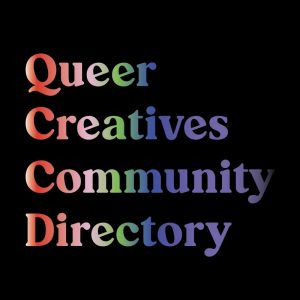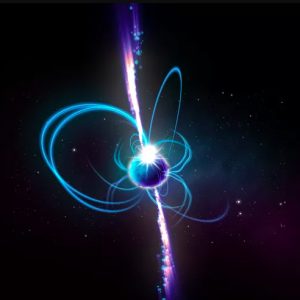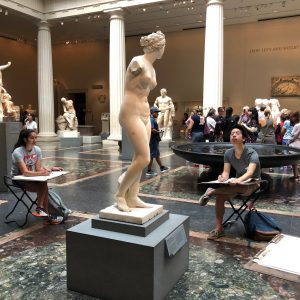Link About It: This Week’s Picks
Art’s influence on medical education, a directory of queer creatives, a new category of star and more from around the web

Aboriginal Flag Finally Free For Public Use
 After a two-year legal battle (and many more years of disputes and conflict), the Aboriginal flag is freely available for public use now that the designer transferred copyright to the Commonwealth in a $20 million deal that supersedes any other holdings. Designed in 1970 by Aboriginal artist Harold Thomas, the black, yellow and red flag became an iconic symbol that represents Indigenous people, the majesty of their land and the unwavering connection between them. Copyright issues came to a head when Gunditjmara woman and CEO of Clothing The Gaps (a hybrid social enterprise and apparel brand), Laura Thompson found out—thanks to being served a cease and desist—that non-Indigenous brand WAM Clothing “held exclusive international rights to sell clothing with the Aboriginal Flag.” (That company, meanwhile, is part-owned by Ben Wooster, whose previous business was fined $2.3 million by the federal court for selling fake Aboriginal art.) The team at Clothing The Gaps and others have worked together since 2020 to secure this new copyright deal. Although it is a win, there are still questions about future custodianship. Thompson tells The Guardian, “I feel like this is as good as we’re going to get in terms of freeing the Aboriginal flag. It is a significant amount of money, but we paid $30m for the boxing kangaroo. Can you compare the significance of the Aboriginal flag to the boxing kangaroo? My grandkids, my great-grandkids, will have the Aboriginal flag in their lives, uniting them and supporting their culture and making them feel safe in community.” Thomas, who rarely speaks out about his immensely important work, says, “I hope this arrangement provides comfort to all Aboriginal people and Australians to use the flag, unaltered, proudly and without restriction. I am grateful that my art is appreciated by so many, and that it has come to represent something so powerful to so many.” Read more at The Guardian.
After a two-year legal battle (and many more years of disputes and conflict), the Aboriginal flag is freely available for public use now that the designer transferred copyright to the Commonwealth in a $20 million deal that supersedes any other holdings. Designed in 1970 by Aboriginal artist Harold Thomas, the black, yellow and red flag became an iconic symbol that represents Indigenous people, the majesty of their land and the unwavering connection between them. Copyright issues came to a head when Gunditjmara woman and CEO of Clothing The Gaps (a hybrid social enterprise and apparel brand), Laura Thompson found out—thanks to being served a cease and desist—that non-Indigenous brand WAM Clothing “held exclusive international rights to sell clothing with the Aboriginal Flag.” (That company, meanwhile, is part-owned by Ben Wooster, whose previous business was fined $2.3 million by the federal court for selling fake Aboriginal art.) The team at Clothing The Gaps and others have worked together since 2020 to secure this new copyright deal. Although it is a win, there are still questions about future custodianship. Thompson tells The Guardian, “I feel like this is as good as we’re going to get in terms of freeing the Aboriginal flag. It is a significant amount of money, but we paid $30m for the boxing kangaroo. Can you compare the significance of the Aboriginal flag to the boxing kangaroo? My grandkids, my great-grandkids, will have the Aboriginal flag in their lives, uniting them and supporting their culture and making them feel safe in community.” Thomas, who rarely speaks out about his immensely important work, says, “I hope this arrangement provides comfort to all Aboriginal people and Australians to use the flag, unaltered, proudly and without restriction. I am grateful that my art is appreciated by so many, and that it has come to represent something so powerful to so many.” Read more at The Guardian.
Image courtesy of Reuters
An Expansive Online Directory of Queer Creatives
 The Queer Creatives Community Directory is a new centralized spreadsheet database of LGBTQ+ people working in all kinds of fields—from DJs and tattoo artists to florists, contractors, tarot readers, ASL interpreters and more. Created by drag artist and graphic designer Untitled Queen, this free, online directory is one of the most expansive of its kind. “Having a resource like this is really great, because people can [use the directory] for visibility,” says the founder. “That’s, straight up, probably the best strategy for any kind of mutual aid, fundraising or community health program—putting money in the pockets of this community.” The database will not only make it easier for queer people to find each other for work, but will also ensure that the spaces they go to are run by people who are welcoming. With the help of Untitled Queen’s friend Jess Ramsay, the spreadsheet will be updated monthly. Learn more about it at Paper Magazine.
The Queer Creatives Community Directory is a new centralized spreadsheet database of LGBTQ+ people working in all kinds of fields—from DJs and tattoo artists to florists, contractors, tarot readers, ASL interpreters and more. Created by drag artist and graphic designer Untitled Queen, this free, online directory is one of the most expansive of its kind. “Having a resource like this is really great, because people can [use the directory] for visibility,” says the founder. “That’s, straight up, probably the best strategy for any kind of mutual aid, fundraising or community health program—putting money in the pockets of this community.” The database will not only make it easier for queer people to find each other for work, but will also ensure that the spaces they go to are run by people who are welcoming. With the help of Untitled Queen’s friend Jess Ramsay, the spreadsheet will be updated monthly. Learn more about it at Paper Magazine.
Image courtesy of Paper Magazine
A New Type of Star Likely Discovered
 Located about 4,000 light-years from the sun, a “mysterious, flickering object” that emits huge amounts of energy every few hours has been discovered. Astronomers watched as the object—named GLEAM-X J162759.5-523504.3—brightened, dimmed and disappeared before reappearing and brightening again, and assumed it was a supernova (a dying star) or a neutron star (an already-dead star) but found that it’s neither. In fact, it could be a new type of star. The lead study author Natasha Hurley-Walker (a radio astronomer) says, “This object was appearing and disappearing over a few hours during our observations. That was completely unexpected. It was kind of spooky for an astronomer because there’s nothing known in the sky that does that.” Find out more at Live Science.
Located about 4,000 light-years from the sun, a “mysterious, flickering object” that emits huge amounts of energy every few hours has been discovered. Astronomers watched as the object—named GLEAM-X J162759.5-523504.3—brightened, dimmed and disappeared before reappearing and brightening again, and assumed it was a supernova (a dying star) or a neutron star (an already-dead star) but found that it’s neither. In fact, it could be a new type of star. The lead study author Natasha Hurley-Walker (a radio astronomer) says, “This object was appearing and disappearing over a few hours during our observations. That was completely unexpected. It was kind of spooky for an astronomer because there’s nothing known in the sky that does that.” Find out more at Live Science.
Image courtesy of ICRAR
How Art is Transforming Medical Education
 Art and science (considered by some to be polar opposites) are intrinsically connected in medical humanities, a rising field that’s proving the disciplines are even stronger when paired together. Artist Anne Willieme’s ArtMed inSight, a consulting agency that brings arts classes to medical institutions, is one such program in this field. Willieme’s classes teach medical students, physicians and healthcare workers to enhance their perception and observational skills by working with various artistic mediums. As art often encourages people to view subjects from different angles, the discipline can help students better absorb information in clinical situations, interpret those findings and diagnose patients better. “Art and science have so much in common,” says Willieme. They “are rooted in a sense of wonder about the world, giving form to an understanding of the world, and deal with interpretation as well.” Learn more about this connection at Hyperallergic.
Art and science (considered by some to be polar opposites) are intrinsically connected in medical humanities, a rising field that’s proving the disciplines are even stronger when paired together. Artist Anne Willieme’s ArtMed inSight, a consulting agency that brings arts classes to medical institutions, is one such program in this field. Willieme’s classes teach medical students, physicians and healthcare workers to enhance their perception and observational skills by working with various artistic mediums. As art often encourages people to view subjects from different angles, the discipline can help students better absorb information in clinical situations, interpret those findings and diagnose patients better. “Art and science have so much in common,” says Willieme. They “are rooted in a sense of wonder about the world, giving form to an understanding of the world, and deal with interpretation as well.” Learn more about this connection at Hyperallergic.
Image courtesy of Anne Willieme
Alejandro Jodorowsky’s “Dune” May Become an Animated Series
 Long before Denis Villeneuve in 2021 (and David Lynch in 1984) brought science-fiction novelist Frank Herbert’s complex, bold and beloved epic Dune to cinemas, the pioneering Chilean French filmmaker Alejandro Jodorowsky attempted to do so. His doomed project, chronicled within the documentary Jodorowsky’s Dune, ended with a comprehensive book of imaginative and meticulously plotted details that encompassed his entire vision—from concept art to storyboarding. On 15 January, a crypto group under the name Spice DAO paid €2.66 million for this book. Although the sale does not grant Spice DAO the rights to do so, they intend to “produce an original animated limited series inspired by the book and sell it to a streaming service.” They also hope to make the art within the compendium public and support projects that draw inspiration from the material, as well. Read more about why they are forging ahead at Dazed.
Long before Denis Villeneuve in 2021 (and David Lynch in 1984) brought science-fiction novelist Frank Herbert’s complex, bold and beloved epic Dune to cinemas, the pioneering Chilean French filmmaker Alejandro Jodorowsky attempted to do so. His doomed project, chronicled within the documentary Jodorowsky’s Dune, ended with a comprehensive book of imaginative and meticulously plotted details that encompassed his entire vision—from concept art to storyboarding. On 15 January, a crypto group under the name Spice DAO paid €2.66 million for this book. Although the sale does not grant Spice DAO the rights to do so, they intend to “produce an original animated limited series inspired by the book and sell it to a streaming service.” They also hope to make the art within the compendium public and support projects that draw inspiration from the material, as well. Read more about why they are forging ahead at Dazed.
Image courtesy of Jodorowsky’s Dune
Remembering Manfred Thierry Mugler Through His Iconic George Michael Collaboration, “Too Funky”
 Manfred Thierry Mugler, an iconic French fashion designer whose garments pushed boundaries and thrilled all those who wore them (or admired them from afar), has passed away at 73. A professional ballet dancer by 14 years old, he moved to Paris in his early 20s and worked as a freelance designer for various houses before launching his eponymous label in 1974. By the ’80s he had established himself as an industry trailblazer, creating dramatic silhouettes and working with unexpected materials. His broad inspirations—from ’40s glamour to late ’70s sci-fi, insects, vampires, mermaids and beyond—manifested in surreal, sublime garments. He created countless legendary moments over his career (including the Botticelli-inspired Venus Dress) and one such sensation was George Michael’s 1992 “Too Funky” music video. The video (centered on a concept by Jeff Beasley, conceived after he saw a Mugler show) was co-directed by Mugler and Michael—with the fashion designer creating all the extraordinary looks. Across four minutes, costume, drama, ingenuity, sex, beauty, audacity and euphoria saturate the screen.
Manfred Thierry Mugler, an iconic French fashion designer whose garments pushed boundaries and thrilled all those who wore them (or admired them from afar), has passed away at 73. A professional ballet dancer by 14 years old, he moved to Paris in his early 20s and worked as a freelance designer for various houses before launching his eponymous label in 1974. By the ’80s he had established himself as an industry trailblazer, creating dramatic silhouettes and working with unexpected materials. His broad inspirations—from ’40s glamour to late ’70s sci-fi, insects, vampires, mermaids and beyond—manifested in surreal, sublime garments. He created countless legendary moments over his career (including the Botticelli-inspired Venus Dress) and one such sensation was George Michael’s 1992 “Too Funky” music video. The video (centered on a concept by Jeff Beasley, conceived after he saw a Mugler show) was co-directed by Mugler and Michael—with the fashion designer creating all the extraordinary looks. Across four minutes, costume, drama, ingenuity, sex, beauty, audacity and euphoria saturate the screen.
Image courtesy of George Michael and Manfred Thierry Mugler
Link About It is our filtered look at the web, shared daily in Link and on social media, and rounded up every Saturday morning. Hero image courtesy of Alejandro Jodorowsky’s Dune












